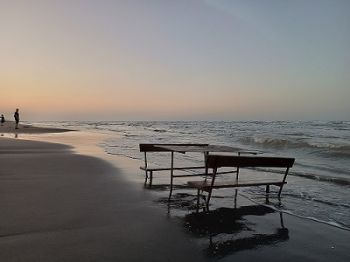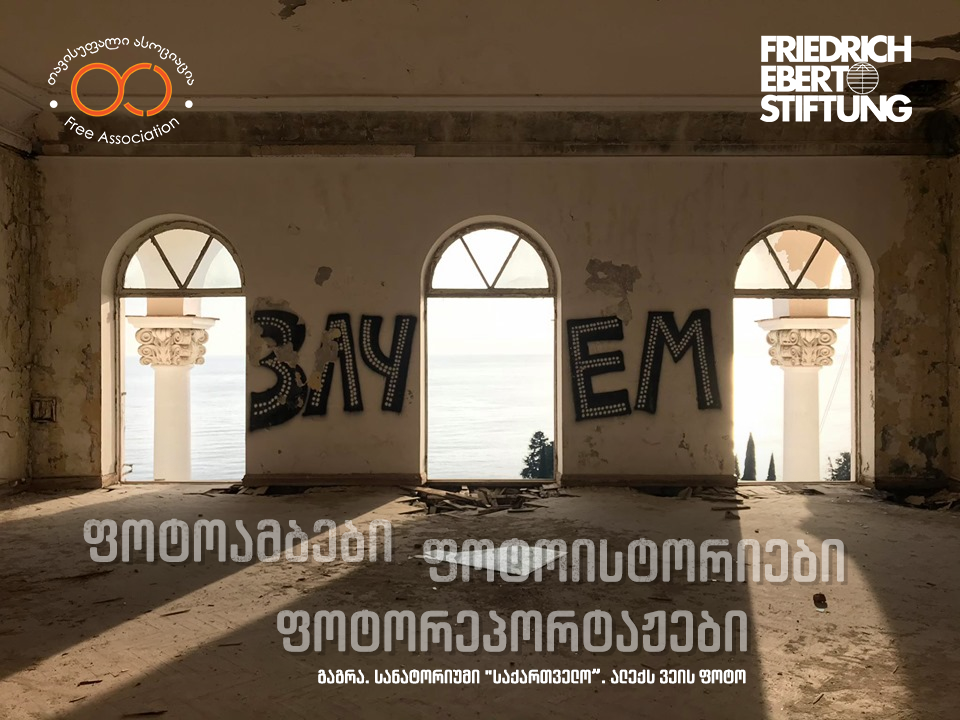69 წლის დაგბეკ სოიუზალიევი, ლაჩინის რაიონის სოფელ ერიკლის მცხოვრები ოთხ ბავშვთან ერთად სანაპიროზე 1992 წელს გადმოსახლდა. ოჯახი ყარაბაღის პირველ ომს გაურბოდა, გაქცევისას მათ თავზე ტყვიები ზუზუნებდა. ის ისევე როგორც მისი თანასოფლელები ტურისტული ბაზის "ჰეზერი" ტერიტორიაზე დასახლდნენ, იალამას დასახლება ბაქოს ჩრდილოეთით 200 კილომეტრშია, რუსეთის საზღვართან ახლოს. დაგბეკისთვის ეს ადგილი ომის შემდეგ მხოლოდ თავშესაფარი არ იყო: "ჩემი თვალები იმდენად დასხივებული იყო, რომ სიბნელეში ყველანაირი ნათელი ფერის დანახვა შემეძლო. მანქანას ფარების ჩართვის გარეშე ვატარებდი,"-ამბობს 20-წლიანი გამოცდილების ტელევიზორის ხელოსანი. ექიმთან კონსულტაციის შემდეგ შესაფერისი სამსახური მოიძია:"აქ რომ არ ჩამოვსულყავი, უსინათლო ვიქნებოდი".
დღეს სოიუზალიევი წყლის მარეგულირებელ კოშკთან განთავსებული კოტეჯებიდან ერთ-ერთში ცხოვრობს. დროთა განმავლობაში იძულებით გადაადგილებული პირები ქვეყნის სხვადასხვა კუთხეში გადავიდნენ. ამჟამად რეგისტრირებულია 47 ოჯახი, მუდმივად მხოლოდ 20 ოჯახი ცხოვრობს.
იალამის კასპიის სანაპირომ დევნილებთან ერთად ადგილობრივი დამსვენებლის ნაწილიც დაკარგა, ასევე, 600-მეტრიანი პლაჟიც. 90-იანი წლების ბოლოს კერძო პირებზე გაასხვისეს. სანაპიროს ნაწილზე კაფეები, პროდუქტით სავაჭრო ადგილები, სოფლის მეურნეობის მოსავლის ბაზარი გაჩნდა. თვითონ ტურისტული ბაზა, სადაც ოდესღაც ერთდროულად 1200 სტუმრის მიღება შეიძლებოდა, 1992 წლის შემდეგ მხოლოდ 301 ადამიანს იტევს.

ამ ადგილას დასასვენებლად თანამშრომლებს პროფკავშირები აგზავნის. კომპანიის მიხედვით თანამშრომლები ტურისტული საგზურის 10-15%-ს იხდიან. აზერბაიჯანის ავიახაზების თანამშრომლები კი 15 დღის განმავლობაში სრულიად უფასოდ ისვენებენ. ძირითადად, ასაკოვანი ადამიანები ჩადიან. ახალგაზრდებს ნაკლებად შეხვდებით, მათი აზრით, მათი ინტერესების შესაბამისი გასართობი ადგილები არ არის.
16 წლის, ორენოვანი თეიმურაზ მამეძადე ბაქოდან მშობლებთან ერთად ჩამოვიდა, გულწრფელად აღიარებს, რომ მოწყენილია. ეს განპირობებულია ნაწილობრივ იმითაც, რომ დამსვენებელთა კონტინგენტი შეიცვალა. საბჭოთა კავშირის დაშლის შემდეგ ბევრმა რუსულენოვანმა მოქალაქემ ქვეყანა დატოვა: "ჩემი მენტალიტეტი აზერბაიჯანულად მოსაუბრე ადამიანებისგან განსხვავებულია. ჩვენ ნაკლები საერთო ინტერესი გვაქვს".
საბჭოთა დროისგან განსხვავებით ტურისტული ადგილი სეზონზე დამსვენებლებს არა ოთხჯერ, არამედ ხუთჯერ იღებს, ყოველ 18 დღეში ახალ ნაკადს. როგორც საბჭოთა კავშირში სამოგზაურო ტურში შედიოდა კორპუსში ან კოტეჯში განთავსება, სამჯერადი კვება და სხვადასხვა სახის გასეირნება, ახლაც ზუსტად ასეა აწყობილი. დამსვენებლების კვებაზე უკანასკნელი 9 წელია ელშან ჯავადოვია პასუხისმგებელი. 48 წლის მმართველს 30 ადამიანი ექვემდებარება. მმართველი ამბობს, რომ ზოგჯერ 400-500 დამსვენებლის გამოკვება უწევთ, მათ შორის, 16 წლის ახალგაზრდების. "სტუმარმა ორი კვირის განმავლობაში ერთი და იგივე სახეობის საჭმელი შეიძლება მხოლოდ ერთხელ ჭამოს. ვცდილობ, ყველაფრით გავუმასპინძლდეთ: საუზმეზე ფაფებით, სადილზე წვნიანებით და ვახშამზე თევზის მწვადებითაც კი.
სეზონზე 120 ადამიანი მუშაობს, უმეტესობა მათგანი იალამისა და შიმალის მაცხოვრებელია. ყოველდღე ავტობუსით სამსახურში დადიან, რომელიც სპეციალურად მათთვის ტურისტულმა ობიექტმა გამოყო.
ჰეზერის დირექტორი მაჰირ შირალიევი ხუმრობს, რომ გასული საუკუნიდან აქ ისვენებს. ტურისტულ ობიექტს 2005 წლიდან ხელმძღვანელობს. მაჰირ შირალიევს სჯერა, რომ აქაური ჰაერი ადამიანის იმუნიტეტს აძლიერებს და არ აშინებს, როცა საკუთარ საქმეში ეფლობა. მისი თქმით, ყოველწლიურად შენდება, ან რესტავრირდება ორი ახალი კოტეჯი, სამზარეულო და სასადილო. უახლოესი მომავლის გეგმებია აუზის გახსნა და ორსართულიანი ახალი ნომრები დამსვენებლებისთვის.
ვინ იცის, იქნებ ვერ მოპოვებული საბჭოთა პოპულარობიდან ინფრასტრუქტურის განახლების შემდეგ ტურისტულმა ობიექტმა "ჰეზერი" შეძლოს საბჭოთა სკოლის გავლენიდან გამოსვლა და ბევრად მაღალ საფეხურზე ასვლა. საბედნიეროდ, იალამის უნიკალური ბუნება ყოველთვის ადგილზეა.
The coast of Caspian Sea was not as popular health resort as Crimea, Sochi and Sokhumi in the Soviet Union. However, the warm and brackish water of the Caspian Sea with its golden sand beaches was distinguished by no less healing abilities. During the years of independence, for some the beach was a place of recreation, for others it was a place of survival.
69-year-old Dagbek Soyuzaliyev, a resident of the village of Erikli, Lachin district, moved to the coast with four children in 1992. The family fled the first Karabakh war as the bullets were flying over their heads. He, like his fellow villagers, settled in the territory of the tourist base "Hezer", the Yalama settlement is 200 kilometers north of Baku, near the Russian border. For Dagbek, this place was not only a refuge after the war: “My eyes were so irradiated that I could see all kinds of bright colors in the dark. I drove the car without turning on the lights," - says the TV technician with 20 years of experience. After consulting a doctor, he looked for a suitable job: "If I hadn't come here, I would have been blind."
Today, Soyuzaliyev lives in one of the cottages near the water control tower. Time by time, internally displaced persons living here moved to different parts of the country. Currently, 47 families are registered in this settlement, but only 20 families live permanently.
It was not only displaced people the Caspian coast of Yalam lost, it also lost a part of the local vacationers, as well as the 600-meter beach. In the late 90s, it was sold to private individuals. Cafes, product trading places, agricultural harvest market appeared on the part of the beach. The tourist base itself, which once could receive 1,200 guests at a time, can accommodate only 301 people after 1992.
Now Trade Unions send employees to this place for vacation. Depending on the company, employees pay 10-15% of the tourist trip. Employees of Azerbaijan Airlines have 15 days of free vacation. Mostly, elderly people arrive. You will rarely meet young people, as in their opinion, there are no entertainment places here that correspond to their interests.
16-year-old Teimuraz Mamedzade came here from Baku with his parents. H honestly admits that he is bored. This is partly due to the fact that the contingent of vacationers has changed. After the collapse of the Soviet Union, many Russian-speaking citizens left the country: "My mentality is different from Azerbaijani-speaking people. We have less common interest”,-he says.
In contrast to Soviet times, the tourist destination receives tourists not four times, but five times during the season. As in the Soviet Union, a travel tour included accommodation in a building or a cottage, three meals and various kinds of excursions, it is organized in exactly the same way now too. For the past 9 years, Elshan Javadovia has been responsible for the meals of the vacationers. 30 people are subordinate to the 48-year-old ruler. The manager says that sometimes they have to feed 400-500 vacationers. "A guest can eat the same type of food only once in two weeks. I try to suggest to them everything: porridge for breakfast, soup for dinner and even grilled fish for dinner.”-he says.
120 people work here during the season, most of them are residents of Yalam and Shimali. Every day they go to work by bus, which was specially allocated for them by the tourist facility.
Heather director Mahir Shiraliev jokes that he has been vacationing here since the last century. He has been managing the tourist facility since 2005. Mahir Shiraliev believes that the air here strengthens immunity. According to him, two new cottages, a kitchen and a dining room are built or restored every year. Plans for the near future include the opening of the pool and new two-story guest rooms.
Who knows, maybe after the renovation of the infrastructure, the tourist object Heather which failed to gain popularity in Soviet Times may be able to free itself from the influence of the past and climb up to a new level. Fortunately, the unique nature of Yalam is always in place.



















